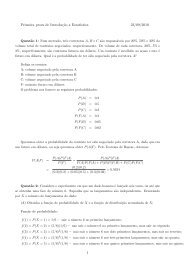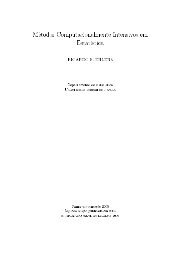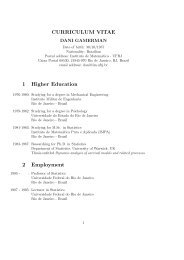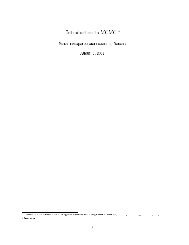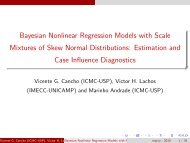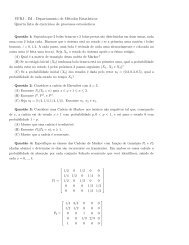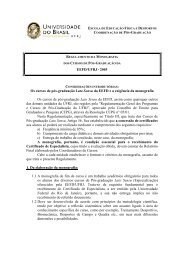Copulas: a Review and Recent Developments (2007)
Copulas: a Review and Recent Developments (2007)
Copulas: a Review and Recent Developments (2007)
You also want an ePaper? Increase the reach of your titles
YUMPU automatically turns print PDFs into web optimized ePapers that Google loves.
We may also characterize other statistics which are relevant in reliability, lifemodeling or risk analysis. For example, one could be interested in the range X n:n ¡X 1:n or subranges X r1 :n ¡ X r2 :n for r 1 >r 2 . However, in order to derive explicitformulas, we need the joint distribution of X r1 :n <strong>and</strong> X r2 :n. In the case of independent<strong>and</strong> identically distributed r<strong>and</strong>om variables, Balakrishnan <strong>and</strong> Cohen (1991) givemore friendly formulas for the density. Nelsen (2003) found the copula C 1;n of X 1:n<strong>and</strong> X n:n :C 1;n (u; v) =v ¡ [maxf(1 ¡ u) 1 1n + v n ¡ 1; 0g] n ;see also Schmitz (2004).In the general case, the problem is open. One solution is then to use Monte Carlomethods, as suggested by Georges et al. (2001). A recent study on the degree ofassociation of pairs of ordered r<strong>and</strong>om variables is provided by Averous et al. (2005).In Anjos et al. (2005) we give a copula representation of the joint distributionfunction of r-th <strong>and</strong> s-th order statistics corresponding to X <strong>and</strong> Y giventhe associated copula C as follows. Consider a bivariate distribution function withcontinuous margins <strong>and</strong> n independent observations from the population (X; Y ).Let (X 1 ;Y 1 );::: ;(X n ;Y n ); n ¸ 2, be a sample from continuous distribution withcopula C <strong>and</strong> marginals F <strong>and</strong> G respectively. Let X r:n <strong>and</strong> Y s:n be the orderstatistics of the sample, 1 · r; s · n: Since F (x) <strong>and</strong>G(y) are continuous thepairs f(X 1 ;Y 1 );::: ;(X n ;Y n )g can be transformed into f(U 1 ;V 1 );::: ;(U n ;V n )g byU i = F (X i ) » U(0; 1) <strong>and</strong> V i = G(Y i ) » U(0; 1). Therefore, we get P (X r:n ·x; Y s:n · y) =P (U r:n · u; V s:n · v); where U r:n <strong>and</strong> V s:n are r-th <strong>and</strong> s-th orderstatistics corresponding to n independent observations from (U; V ).The marginal distributions of P (U r:n · u; V s:n · v) are Beta distributed r<strong>and</strong>omvariables, i.e. U r:n » Beta(r; n ¡r +1) <strong>and</strong> V s:n » Beta(s; n¡s+1). Let ¯¡1¯¡1r;n¡r+1 <strong>and</strong>s;n¡s+1 be the inverses of these Beta distributions. The copula associated to orderstatistics of the pair (X r:n ;Y s:n ) is the same copula of the pair (U r:n ;V s:n ), i.e.C Xr:n ;Y s:n(w; t) =C Ur:n ;V s:n(w; t) =H Ur:n ;V s:n¡¯¡1r;n¡r+1(w);¯¡1s;n¡s+1(t) ¢ :Under the above notations the copula C Ur:n ;V s:nis given byC Ur:n;V s:n(w; t) =nXj=rnX X n!C ¡¯¡1r;n¡r+1(w);¯¡1s;n¡s+1(t) ¢ mm!(j ¡ m)!(k ¡ m)!(n ¡ j ¡ k + m)!k=sm(4)£ [¯¡1r;n¡r+1 (w) ¡ C(¯¡1r;n¡r+1 (w);¯¡1s;n¡s+1 (t))]j¡m£ [¯¡1s;n¡s+1£ [1 ¡ ¯¡1r;n¡r+1 (w) ¡ ¯¡1(t) ¡ C(¯¡1r;n¡r+1 (w);¯¡1s;n¡s+1 (t))]k¡ms;n¡s+1(t)+C¡¯¡1r;n¡r+1 (w);¯¡1where the third summation is over m 2 [max(0;j+ k ¡ n);min(j; k)]:s;n¡s+1 (t)¢ ] n¡j¡k+m ;20




